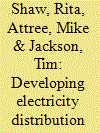| Srl | Item |
| 1 |
ID:
098642


|
|
|
|
|
| Publication |
2010.
|
| Summary/Abstract |
A more sustainable energy system will alter the current patterns of electricity demand and generation. This means technical, commercial and regulatory change for electricity network systems such as distribution networks. This paper traces the links in Great Britain between changes in energy policy since privatisation, changes in the objectives of the electricity regulator and changes in the objectives of the distribution networks and their owners, the distribution network operators (DNOs). The paper identifies tensions in regulatory policy and suggests reforms to the regulatory framework to support a lower-carbon future.
DNOs are licensed regional infrastructure providers. In addition to their network services, the network companies can potentially deliver public policy objectives to facilitate heat infrastructure, energy-efficiency and distributed renewables. The paper identifies the potential benefits of a novel approach to facilitating renewable energy feed-in tariffs for electricity and heat, using DNOs.
|
|
|
|
|
|
|
|
|
|
|
|
|
|
|
|
| 2 |
ID:
115126


|
|
|
|
|
| Publication |
2012.
|
| Summary/Abstract |
A reconfigurable network can change its topology by opening and closing switches on power lines. We use real wind, solar, load, and cost data and a model of a reconfigurable distribution grid to show that reconfiguration allows a grid operator to reduce operational losses as well as to accept more intermittent renewable generation than a static configuration can. Net present value analysis of automated switch technology shows that the return on investment is negative for this test network when considering only loss reduction, but that the investment is attractive under certain conditions when reconfiguration is used to minimize curtailment.
|
|
|
|
|
|
|
|
|
|
|
|
|
|
|
|
| 3 |
ID:
121281


|
|
|
|
|
| Publication |
2013.
|
| Summary/Abstract |
New developments towards a more sustainable energy delivery system require electricity distribution grids that support distributed generation and a potential increase in electricity demand. In this article, the impact of changes in future residential use on the electricity distribution grids is assessed by using a scenario-based methodology to model residential loads. It illustrates that scenarios resulting from varied economic and demographic developments, but also driven by the focus of energy policies, can have considerable consequences on the loading and the resulting required network capacities of electricity distribution grids. A strategy for network operators to cope with these changes and optimise the utilisation of their grids is to use the possibilities to control flexible loads to reduce peak loads and shift demands. This article shows that if these loads can be managed in such way, the electricity profiles can be flattened significantly. For the case of the Netherlands, the peak demands in residential areas can be reduced with 35-67% in various scenarios. Load-flow analyses of medium voltage networks show that a load management strategy to reduce peak demands can realise a reduction of 21-40% for required capacity of cables and transformers. This makes a reduction 45-72% in investment costs possible.
|
|
|
|
|
|
|
|
|
|
|
|
|
|
|
|